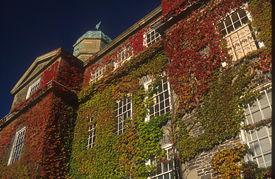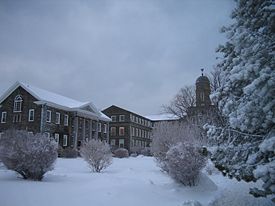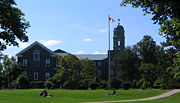Dalhousie University
| Dalhousie University | |
|---|---|
|
|
|
| Motto: | Latin: Ora et Labora (English: Pray and work) |
| Established: | 1818 |
| Type: | Public |
| Religious affiliation: | non-denominational |
| Endowment: | $364 million[1] (as of December 31, 2007) |
| Chancellor: | Fred Fountain |
| President: | Tom Traves |
| Undergraduates: | 12,060 |
| Postgraduates: | 3,460 |
| Location: | Halifax, Nova Scotia, Canada |
| Campus: | Urban |
| Colours: | black & gold |
| Nickname: | Tigers |
| Affiliations: | AUCC, IAU, ACU, CIS, CUSID, AUS |
| Website: | http://www.dal.ca/ |
Dalhousie University is a university located in Halifax, Nova Scotia, Canada.
As the largest post-secondary educational institution in the Maritime Provinces it offers a wide array of programs, including a medical program and the Dalhousie Law School. The chancellor is Mr. Fred Fountain; Dr. Tom Traves serves as president and vice-chancellor.
Dalhousie is consistently named among Canada's top research universities. It is a member of the Group of Thirteen, more commonly referred to as the G13, a group of the leading universities in Canada.
Contents |
History
Dalhousie College is a non-denominational university founded in 1818 by the 9th Earl of Dalhousie, the Lieutenant-Governor of Nova Scotia. [2] Dalhousie University awarded its first BA in 1866.
Using money acquired from the duties collected during the occupation of parts of Maine in the War of 1812, Ramsay established Dalhousie as a college open to all people regardless of class or creed. At the laying of the cornerstone on May 22, 1820, Lord Dalhousie said that this University was "founded on the principles of religious tolerance." Dalhousie remained one of only three universities founded on secular constitutional premises until as late as the 1950s. Although it was technically founded in 1818, Dalhousie did not have its first students until November 1st, 1838. However, following the Death of the University's first principal, Thomas McCulloch, in 1843 the school was once again allowed to fall into inactivity. Dalhousie did not permanently open its door again until November 10, 1863.
In 1876 the experiment was commenced in Halifax, Nova Scotia of a University to hold examinations in arts, law, and medicine, and to confer degrees. [3]
Dalhousie was distinctive as an urban institution, situated in downtown Halifax on the site of the present City Hall. This status was seen not only, in the early days at least, in the use of much of the college's lowest floor as vault space for Oland Brewery, but also in the consistent drawing of about one-third of the student body from the city and in the college's ability to draw upon local professional populations in the establishment of professional faculties such as medicine (1868) and law (1883). Finances remained difficult into the 1880s, but by the end of that decade the accumulated donations of the George Munro, brother-in-law of Board of Governors member John Forrest, had provided the stimulus that led to growth in student numbers and the emergence of Dalhousie as a centre of scholarship acknowledged throughout the dominion.
The Halifax Conservatory became affiliated with Dalhousie in 1889. [2]

In 1920 the University of King's College in Windsor, Nova Scotia, English Canada's oldest degree granting institution, burned down. Through a grant from the Carnegie Foundation, King's College was able to relocate to Halifax and entered into a partnership with Dalhousie University. While often seen as a separate but integrated institution it shares Dalhousie's Arts and Sciences Faculty, but offers several interdisciplinary humanities degree programmes, such as Contemporary Studies, History of Science and Technology and Early Modern Studies.
In 1936, the Institute of Public Affairs was established at Dalhousie University.
Dalhousie expanded its presence in south-end Halifax during the 1960s and 1970s when it built the Dalplex athletic facility, the Killam Library, the Life Sciences Centre, the Dalhousie Student Union building and a district heating plant, all on what is referred to as the Studley Campus (the main campus). Also at this time, Dalhousie built the Tupper Building for its Faculty of Medicine and expanded existing buildings to house the Faculty of Dentistry and College of Pharmacy, all on the adjacent Carleton Campus, located immediately to the east of the Studley Campus, and co-located with two of Halifax's teaching hospitals (the Victoria General Site of the Queen Elizabeth II Health Sciences Centre and the IWK Health Centre for Women, Children, and Youth).
Nova Scotia Technical College in Halifax launched its program in architecture in 1961. Nova Scotia Technical College was later the Technical University of Nova Scotia (TUNS). [4] Following a period of government-mandated consolidation of post-secondary institutions during the 1990s, the Technical University of Nova Scotia was merged with Dalhousie University in 1997. It was initially known as Dalhousie University Polytechnic, or DalTech, but in 2000 the DalTech nickname was dropped and the engineering, architecture and computer science faculties of TUNS are fully integrated into Dalhousie University. The Faculty of Engineering and the Faculty of Architecture and Planning are located on the Sexton Campus, east of the Carleton Campus and closer to downtown Halifax. The Faculty of Computer Science moved to its own building on Studley Campus in 1999.
Faculties and departments

Dalhousie comprises eleven faculties:
- Architecture and Planning The following degrees are offered: Bachelor of Commmunity Design, Bachelor of Community Design Honours, Master of Planning, Master of Planning Studies, Bachelor of Environmental Design Studies, Master of Architecture
- Arts and Social Sciences
- Computer Science
- Dentistry
- Engineering Students can choose to specialize in the following disciplines: Biological Engineering, Chemical Engineering, Civil Engineering, Electrical Engineering, Industrial Engineering, Mechanical Engineering, Metallurgical Engineering and Mining Engineering [5]
- Graduate Studies
- Health Professions
- Law
- Management
- Medicine
- Science
Current issues
Dalhousie's preliminary enrolment for 2007-08 consists of 10,254 full-time undergraduate students and 2,793 full-time graduate students[6]. Dalhousie has balanced 20 straight budgets, but like many of Canada's universities, is facing long-term challenges in deferred maintenance.
The university is going through a building phase. A new building for the Faculty of Computer Science opened in October 1999 followed shortly thereafter by the Marion McCain Arts and Social Sciences Building. The Howe Hall residence was expanded with the addition of Fountain House and a new residence was also built, named John Risley Hall. The Kenneth C. Rowe Management Building opened in October 2005. The university is preparing to construct a new academic building shortly, and has received $15 million from the federal government towards the construction of a new Life Sciences Research Institute, which the university will share with project partners Capital Health and the IWK Health Centre.
On March 6 and 7 2007, the Dalhousie Student Union held a referendum on a plan from the university administration which proposed the addition of new student areas and the renovation of existing spaces across the Dalhousie campus[7]. The final vote was No, with 57.3% of voters agreeing that the proposed improvements were unnecessary or should not be funded solely by student dollars. Had the referendum succeeded, the construction and renovations would have been funded through an increase in student fees of $10.00 per course, reaching a maximum of $100 per year, for several decades.
Dalhousie is noted as one the top research facilities in Canada and was ranked number 8 for its category in Maclean's for the year of 2007.
Trivia
- The original campus was designed by Andrew R. Cobb.
- The first Friday in February of each year is Munro Day, a holiday celebrating financial contributions made to the school in its infancy by George Munro.
- The newest building built on the Dalhousie Campus is the Kenneth C. Rowe Management Building.
- Dalhousie's campus newspaper, the Dalhousie Gazette, was founded in 1868, making it the oldest student newspaper in Canada and one of the oldest continuously-running student newspapers in North America.
- Dalhousie's colours of black and gold came from the jerseys worn by the Dalhousie University Rugby Football Club (who still wear those colours, as well as the school crest on their jerseys).
- Among North American universities, only Harvard, Yale, Princeton, McGill and the University of Toronto boast more Rhodes Scholars than Dalhousie.
Notable Dalhousie University people
- Further information: List of Dalhousie University people
Faculty members

- Dr. Stephen L. Bearne - Biochemistry
- Dr. Mike Gray - Biochemistry, Evolution
- Dr. Ford Doolittle - Biochemistry, Evolution
- Dr. Axel Becke - Chemistry
- Dr. Stanimir Bonev - Physics
- Dr. Jonathan Borwein - Computer Science, Experimental mathematics
- Dr. David M. Cameron - Political Science
- Dr. Vlado Keselj - Computer Science, Natural Language Processing
- Dr. Hans Jürgen Kreuzer - Physics
- Dr. J. Michael Lee - Biomedical Engineering
- Dr. Evangelos E. Milios - Computer Science, Machine Learning
- Dr. Patrick McGrath - Psychology
- Dr. Lars Osberg - Economics
- Dr. Jane Parpart - International Development Studies
- Dr. Shelly Phipps - Economics
- Dr. Victor F. Rafuse - Anatomy & Neurobiology/Neuroscience
- Dr. Robert Rosen - Biophysics
- Dr. Keith R. Thompson - Oceanography, Statistics
- Dr. Richard J. Wood - Math
- Dr. Norbert Zeh - Computer Science, Algorithms
Alumni
(See Dalhousie Law School for law school alumni.)
- Richard Bennett Hatfield, former Premier of New Brunswick
- Frank Bainimarama - Military Dictator Of Fiji
- Scott Brison, Canadian Member of Parliament and past Candidate for leadership of the Liberal Party of Canada - Bachelor of Commerce
- Barbara Fris, Canadian operatic soprano - Bachelor of Music (Performance) http://www.barbarafris.com
- Erik Demaine - MacArthur Fellowship recipient
- George Laurence - nuclear physicist
- Michael Leir, Canadian High Commissioner to Australia
- Shaun Majumder, Actor/Comedian
- Alexa McDonough, previous national leader of the NDP
- Lucy Maud (L.M.) Montgomery, author of Anne of Green Gables (attended 1895, 1896)
- Chris Murphy, Bassist and vocalist of rock group Sloan
- Kathryn D. Sullivan, First American woman to walk in space
- George Elliot Clarke, Author and recipient of the Governor General's Award
- Charles Peter McColough, Xerox CEO "great American business leader"
- Kishore Mahbubani, former Ambassador of the Republic of Singapore to the United Nations, Dean of the Lee Kuan Yew School of Public Policy
- Adel Iskandar, author.
Athletics
The University’s Department of Athletics and Recreational Services are represented in Atlantic University Sport (AUS) competition by the Dalhousie Tigers. Dalhousie has 14 varsity teams including men’s and women’s teams in cross country, soccer, track and field, basketball, hockey, volleyball and swimming. Representing these teams are over 300 athletes, coaches, trainers and managers.
Since 1990, the Dalhousie Tigers have brought home 127 AUS championships, five Canadian Interuniversity Sport (CIS) team championships and numerous individual national medals. During the 2007-08 varsity season the Tigers captured six AUS championships including: men’s cross country, men’s volleyball, men’s swimming, women’s swimming, men’s track and field, and women’s track and field.
Dalhousie also has dozens of intramural and club sports, from rock climbing and rugby to field hockey and sailing.
Dalhousie Baseball Club
The Dalhousie baseball club was established in 1995 when the Canadian Intercollegiate Baseball Association was formed. They won their first Canadian championship the year later in 1996. Since then they have made the national championship weekend 5 times including a 3 year stretch in 2005, 2006, 2007 reaching the playoffs in the Nationals every year with the championship game in 2006. They have produced 1 Championship MVP Trevor Wamback in 1996 who was soon after drafted by the Montreal Expos out of Dalhousie. In total they have been selected as 2 top pitcher, 2 top hitters, 1 top catcher and 7 All Canadians. They are currently doing their own recruiting.
Fight song
Notable among a number of songs commonly played and sung at various events such as commencement and convocation, and athletic games are: Carmina Dalhousiana (Halifax 1882).[8]
Notes
- ↑ Vice-President (Finance and Administration) Investment Performance Notice (June 28, 2006). [1]. Retrieved february 20, 2008.
- ↑ 2.0 2.1 Dalhousie University
- ↑ http://www.gutenberg.org/dirs/etext04/tlctd10.txt The Project Gutenberg EBook #6466 of 'The Intellectual Development of the Canadian People, A historical review' by John George Bourinot, House of Commons, Ottawa, February 17th, 1881
- ↑ Architectural Education
- ↑ Canadian Engineering Memorial Foundation - University List
- ↑ Association of Atlantic Universities (2007). Survey of Preliminary Enrolments as of October 1, 2007. Retrieved December 11, 2007.
- ↑ Dalhousie News (2007). Dalhousie News - A chance to shape Dalhousie for the better.
- ↑ Dalhousie University Song-book, compiled by Charles B. Weikel [Halifax 1904] http://www.thecanadianencyclopedia.com/index.cfm?PgNm=TCE&Params=U1ARTU0000759SUBReadings
See also
- Dalhousie Law School
- Dalhousie Tigers - varsity athletics teams
- Fenwick Place
- Fraternities and sororities at Dalhousie University
- Rebecca Cohn Auditorium, a concert hall in the Dalhousie Arts Centre
- University of King's College
- Canadian Interuniversity Sport
- Canadian government scientific research organizations
- Canadian university scientific research organizations
- Canadian industrial research and development organizations
- List of agricultural universities and colleges
- List of universities with industrial engineering faculty
- List of colleges and universities named after people
- Higher education in Nova Scotia
Histories of the University
- Heather Alder 'The Lives of Dalhousie University, Vol. 1: Lord Dalhousie's College, 1818-1925' (Montreal: McGill-Queen's University Press, January 6, 1994)
- Dr. Peter Busby Waite, PhD. Professor Emeritus 'The Lives of Dalhousie University' Vol I (Montreal: McGill-Queen's University Press, 1994)
- Dr. Peter Busby Waite, PhD. Professor Emeritus 'The Lives of Dalhousie University' Vol II (Montreal: McGill-Queen's University Press, 1998)
- Henry Roper and James W. Clark. "Religion and Intellectual Freedom on the Dalhousie Campus in the 1920s: The Case of Norman J. Symons." Dalhousie Review 69, no. 2 (Spring 1989).
External links
- Dalhousie University
- The Buildings of Dalhousie
- Dalhousie Gazette - Student Newspaper
- Webcam views of Dalhousie
- Dalhousie University Faculty of Computer Science
- Dalhousie University School of Biomedical Engineering
- DSU Events Posting
- CKDU - Listen online
- Dalhousie Law School
- Dalhousie Academic Timetable
- Review of The Lives of Dalhousie University
- The Earls of Dalhousie
- Dalhousie Senior Administration Salaries
- Dalhousie Athletic & Recreational Services
- Dalhousie University Faculty of Medicine
|
|||||
| Nova Scotia universities | |||
|---|---|---|---|
| Acadia | Atlantic School of Theology | Cape Breton | Dalhousie | University of King's College | Mount Saint Vincent | NSAC | NSCAD | Saint Francis Xavier | Saint Mary's | Saint Anne | |||
|
||||||||